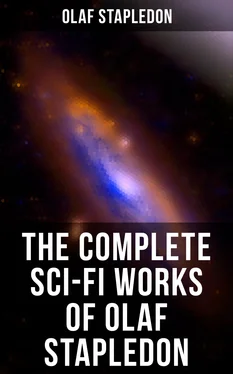Spatially, also, man is inconceivably minute. If in imagination we reduce this galaxy of ours to the size of an ancient terrestrial principality, we must suppose it adrift in the void with millions of other such principalities, very remote from one another. On the same scale the all-embracing cosmos would bulk as a sphere whose diameter was some twenty times greater than that of the lunar orbit in your day; and somewhere within the little wandering asteroid-like principality which is our own universe, the solar system would be an ultra-microscopic point, the greatest planet incomparably smaller.
We have watched the fortunes of eight successive human species for a thousand million years, the first half of that flicker which is the duration of man. Ten more species now succeed one another, or are contemporary, on the plains of Neptune. We, the Last Men, are the Eighteenth Men. Of the eight pre-Neptunian species, some, as we have seen, remained always primitive; many achieved at least a confused and fleeting civilization, and one, the brilliant Fifth, was already wakening into true humanity when misfortune crushed it. The ten Neptunian species show an even greater diversity. They range from the instinctive animal to modes of consciousness never before attained. The definitely subhuman degenerate types are confined mostly to the first six hundred million years of man’s sojourn on Neptune. During the earlier half of this long phase of preparation, man, at first almost crushed out of existence by a hostile environment, gradually peopled the huge north; but with beasts, not men. For man, as man, no longer existed. During the latter half of the preparatory six hundred million years, the human spirit gradually awoke again, to undergo the fluctuating advance and decline characteristic of the pre-Neptunian ages. But subsequently, in the last four hundred million years of his career on Neptune, man has made an almost steady progress toward full spiritual maturity.
Let us now look rather more closely at these three great epochs of man’s history.
Table of Contents
It was in desperate haste that the last Venerian men had designed and fashioned the new species for the colonization of Neptune. The mere remoteness of the great planet, moreover, had prevented its nature from being explored at all thoroughly, and so the new human organism was but partially adapted to its destined environment. Inevitably it was a dwarf type, limited in size by the necessity of resisting an excessive gravitation. Its brain was so cramped that everything but the bare essentials of humanity had to be omitted from it. Even so, the Ninth Men were too delicately organized to withstand the ferocity of natural forces on Neptune. This ferocity the designers had seriously underestimated; and so they were content merely to produce a miniature copy of their own type. They should have planned a hardy brute, lustily procreative, cunning in the struggle for physical existence, but above all tough, prolific, and so insensitive as to be scarcely worthy of the name man. They should have trusted that if once this crude seed could take root, natural forces themselves would in time conjure from it something more human. Instead, they produced a race cursed with the inevitable fragility of miniatures, and designed for a civilized environment which feeble spirits could not possibly maintain in a tumultuous world. For it so happened that the still youthful giant, Neptune, was slowly entering one of his phases of crustal shrinkage, and therefore of earthquake and eruption. Thus the frail colonists found themselves increasingly in danger of being swallowed in sudden fiery crevasses or buried under volcanic dust. Moreover, their squat buildings, when not actually being trampled by lava streams, or warped and cracked by their shifting foundations, were liable to be demolished by the battering-ram thrust of a turbulent and massive atmosphere. Further, the atmosphere’s unwholesome composition killed all possibility of cheerfulness and courage in a race whose nature was doomed to be, even in favourable circumstances, neurotic.
Fortunately this agony could not last indefinitely. Little by little, civilization crumbled into savagery, the torturing vision of better things was lost, man’s consciousness was narrowed and coarsened into brute-consciousness. By good luck the brute precariously survived.
Long after the Ninth Men had fallen from man’s estate, nature herself, in her own slow and blundering manner, succeeded where man had failed. The brute descendants of this human species became at length well adapted to their world. In time there arose a wealth of subhuman forms in the many kinds of environment afforded by the lands and seas of Neptune. None of them penetrated far towards the Equator, for the swollen sun had rendered the tropics at this time far too hot to support life of any kind. Even at the pole the protracted summer put a great strain on all but the most hardy creatures.
Neptune’s year was at this time about one hundred and sixty-five times the length of the old terrestrial year. The slow seasonal change had an important effect on life’s own rhythms. All but the most ephemeral organisms tended to live through at least one complete year, and the higher mammals survived longer. At a much later stage this natural longevity was to play a great and beneficial part in the revival of man. But, on the other hand, the increasing sluggishness of individual growth, the length of immaturity in each generation, retarded the natural evolutionary process on Neptune, so that compared with the Terrestrial and Venerian epochs the biological story now moves at a snail’s pace.
After the fall of the Ninth Men the subhuman creatures had one and all adopted a quadruped habit, the better to cope with gravity. At first they had indulged merely in occasional support from their knuckles, but in time many species of true quadrupeds had appeared. In several of the running types the fingers, like the toes, had grown together, and a hoof had developed, not on the old finger-tips, which were bent back and atrophied, but on the knuckles.
Two hundred millions years after the solar collision innumerable species of subhuman grazers with long sheep-like muzzles, ample molars, and almost ruminant digestive systems, were competing with one another on the polar continent. Upon these preyed the subhuman carnivora, of whom some were built for speed in the chase, others for stalking and a sudden spring. But since jumping was no easy matter on Neptune, the cat-like types were all minute. They preyed upon man’s more rabbit-like and rat-like descendants, or on the carrion of the larger mammals, or on the lusty worms and beetles. These had sprung originally from vermin which had been transported accidentally from Venus. For of all the ancient Venerian fauna only man himself, a few insects and other invertebrates, and many kinds of micro-organisms, succeeded in colonizing Neptune. Of plants, many types had been artificially bred for the new world, and from these eventually arose a host of grasses, flowering plants, thick-trunked bushes, and novel sea-weeds. On this marine flora fed certain highly developed marine worms; and of these last, some in time became vertebrate, predatory, swift, and fish-like. On these in turn man’s own marine descendants preyed, whether as subhuman seals, or still more specialized subhuman porpoises. Perhaps most remarkable of these developments of the ancient human stock was that which led, through a small insectivorous bat-like glider, to a great diversity of true flying mammals, scarcely larger than humming birds, but in some cases agile as swallows.
Nowhere did the typical human form survive. There were only beasts, fitted by structure and instinct to some niche or other of their infinitely diverse and roomy world.
Читать дальше












